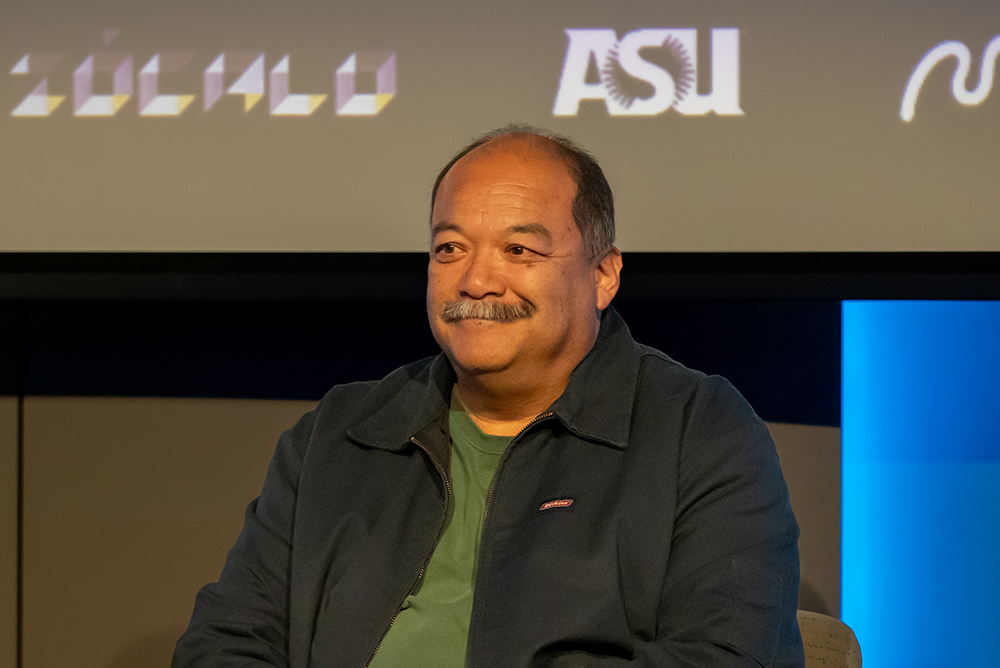
Photo by Tom & Kasi Beck.
Richard A. Lou is a visual and performance artist and professor of art at the University of Memphis. Before serving as a panelist for “What Kind of Monuments Do We Deserve?,” the second program in the Mellon Foundation-supported series “How Should Societies Remember Their Sins?,” he joined us in the green room to talk about hammerhead sharks, the monuments of his childhood, and the family history he’s turning into a graphic novel.
What’s one thing you do to relax?
I like building wooden toys for my grandchildren. I built a cart that’s shaped like a hammerhead shark. That was fun.
Why the hammerhead?
I had an experience with a hammerhead, so I guess it just sort of popped in my head. My father had a small boat. And we would go out fishing every once in a while. We were off of Point Loma, probably a couple of miles offshore. We’re out there, chatting away. It was my dad, me, and a neighborhood friend of ours. All of a sudden, we got quiet at the same time. The shark was longer than our boat. And it was basking; the fin was out of the water. And then it left. It left an amazing impression on me.
What did you want to be growing up?
My father. I always thought he had the most amazing life anyone could have. He grew up here in Mississippi, as part of the Delta Chinese. But they would ship them back and forth between China and the United States because of the Jim Crow laws not allowing for Chinese to go to the Black schools or the white schools. And then the war broke out, and he joined the Marine Corps and fought in World War II. As a kid, unfortunately, we have a tendency to romanticize war. And if someone that you love and respect was part of that endeavor, then you have this connection to it. So I wanted to be a tank commander, of all things. But I quickly grew out of that one.
What’s a project that you’re excited about?
I’ve been writing the stories of my family down for a while. I’m getting older. I’m 64. I’m closer to the end than the middle or beginning, so there’s a large part of me that wants to make sure my grandchildren—who are 4 and 2—continue to hear my voice. I’ve asked my friend Lisa, who draws and paints, if we can work on a graphic novel to tell these stories.
Can you share one piece of family lore with us?
My father would tell this story to reinforce how important education is. His father, who was not really his father, because my father was a paper son—this man decided to bring my father to the United States. He was illiterate. [On his way to the U.S.], he wanted to write a letter to his mother to let her know that he was leaving. And so he found what he considered an educated man, and he asked the man, “Can you write a letter to my mother? I’m leaving for Gold Mountain.” He said, “Sure, but we’re in the middle of the street. Where am I going to write this letter?” And my grandfather said, “You can use my back.” So my grandfather hunched over, so this educated man could write this letter to my grandfather’s mother, letting her know that he may never see her again. My father’s father would tell him this story, and he would say at the end that when he was hunched over, being used as a sort of inanimate object, it felt like 1,000 years had passed because he was humiliated by needing the services of this educated man.
What’s the first monument that moved you?
Probably the Statue of Liberty, which they indoctrinated us with in school. That’s the first one in my memory. Also, the monuments the Yaqui Indians would have in the glorietas—the turnarounds—in Tijuana. I was always fascinated by those, but I had no information about them until later on as an adult. There were a lot more monuments in Mexico, in Tijuana, growing up than in San Diego growing up.



